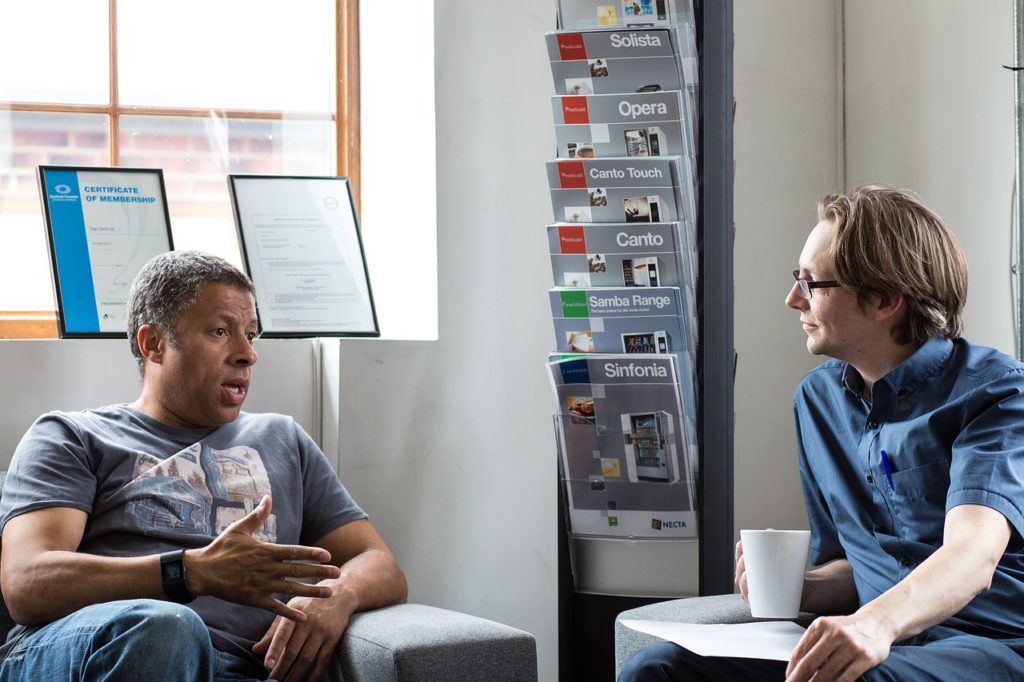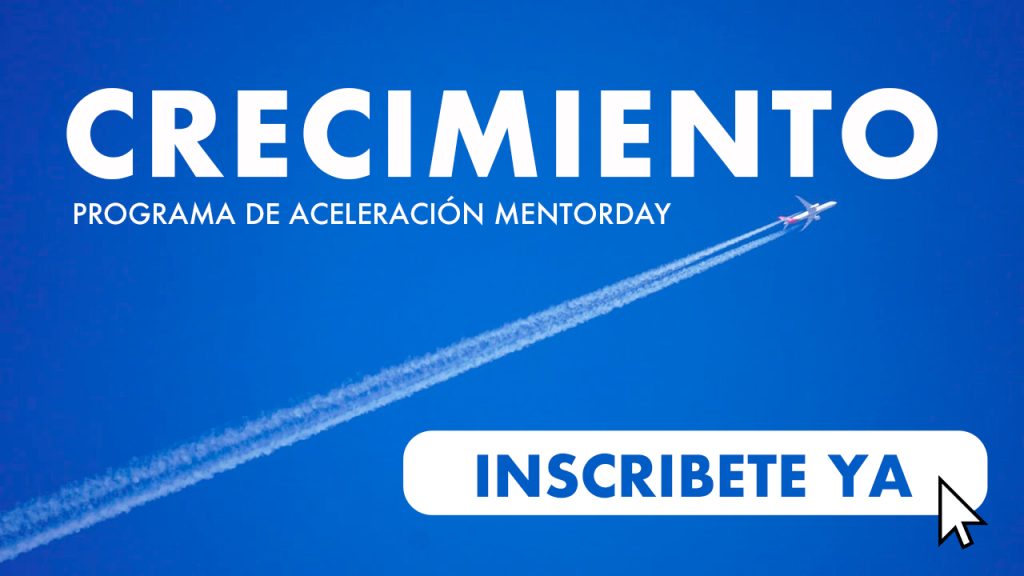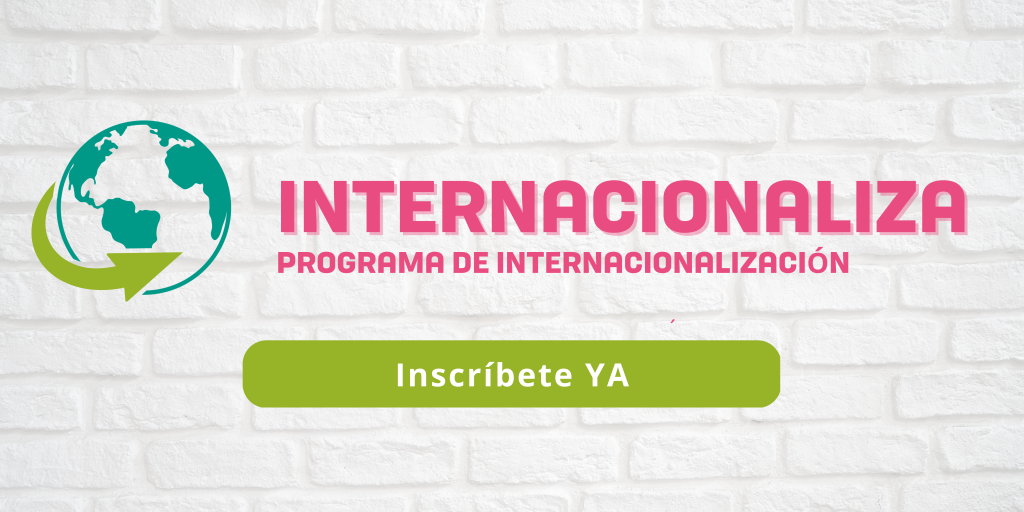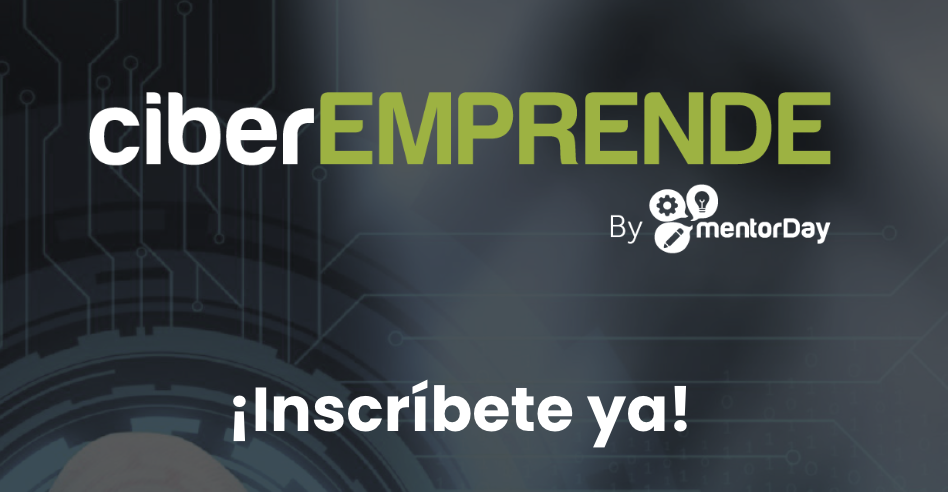GENERANDO RAPPORT EN LA RELACIÓN DE MENTORING CON EMPRENDEDORES
El rapport trata la relación de comunicación o compenetración, en donde se crea un clima de confianza y entendimiento. Esta técnica se trabaja en los procesos de coaching y/o mentoring comercial para entrenar a equipos de ventas.
Existe un rapport verbal para generar empatía en la otra persona donde intentamos devolver lo que acaba de decir la otra persona con una breve introducción, resumiendo lo esencial de forma organizada. Pero también, podemos utilizar, un rapport no verbal. En este caso, el acompañamiento que utilizamos, se realiza mediante un lenguaje no verbal, a través de gestos.
Todos ya pasamos por situaciones en que, aún frente a una propuesta ventajosa o de un consejo valioso, el interlocutor parecía no estar dispuesto a oír, ¿no es verdad? El motivo es que más allá de las buenas intenciones, necesitamos establecer condiciones para que el emprendedor se sienta cómodo para tomar decisiones y actuar. Para eso, es fundamental crear un vínculo de confianza, armonía y cooperación.
En esta TIP, aprenderás sobre como generar rapport para ser más eficiente al comunicarte con tu emprendedor y también con tus amigos, familiares, clientes, proveedores y asociados.
¿Qué es rapport?
En “Introducción a la Programación Neurolingüística: cómo entender e influenciar a las personas”, Joseph O’Connor y Seymour presentan una concepción de rapport relacionada a la idea de empatía:
«En el campo de la educación, de la terapia, del asesoramiento psicológico, en el mundo profesional, de ventas o de entrenamiento, la empatía, que en el lenguaje de la PNL se llama rapport, es esencial para crear una atmósfera de confianza y de participación en la cual las personas puedan reaccionar libremente».
La noción de “crear una atmósfera” es importante para no confundir el rapport con la manipulación del interlocutor. El objetivo es ofrecer condiciones o construir ciertos pilares que harán la comunicación más eficiente.
¿Cuáles son los principales elementos del rapport?
En las comunicaciones interpersonales en que existe rapport, notamos ciertos patrones. Si logramos incorporarlos a nuestro lenguaje, estaremos más cerca de construir pilares de confianza, armonía y cooperación.
CONTACTO VISUAL:
- En el rapport existe un sincronismo en relación al contacto visual. El foco se establece en la medida correcta para transmitir seguridad, variando de frecuencia y duración según las características de la persona con la que hablamos.
- Un tímido, por ejemplo, se sentirá confortable con movimientos más eventuales, mientras otros con contactos más continuos. Todo depende de entender la situación y adaptarse correctamente a cada persona.
EQUILIBRIO EMOCIONAL:
- Otro punto relevante es evitar los excesos.
- La comunicación es una vía de dos manos en la que tanto provocamos como tenemos reacciones.
-
- Entonces, aún si una persona durante la conversación dice algo que no nos gusta, hay límites para nuestra respuesta, incluso porque nosotros mismos podemos estar equivocados respecto de las intenciones de la otra persona.
TONO DE VOZ:
- A veces, comunica más que las propias palabras. Un simple “buen día” puede ser un deseo sincero, cumplir una formalidad, o hasta pasar un toque de sarcasmo.
- La forma de expresarnos debe ser compatible con la intención al hablar.
DESARROLLO:
- La comunicación debe ser armoniosa. Además del tono, debemos tener cuidado con el volumen y el ritmo, espejando lo máximo posible el comportamiento del interlocutor.
- Si una persona comunica algo de forma acelerada y respondemos con poca energía, podemos parecer desinteresados y poco empáticos, solo para citar un ejemplo.
COMUNICACIÓN NO VERBAL:
- Los gestos, la postura y las expresiones faciales también interfieren. Y eso, exige un cuidado especial, porque muchas veces adoptamos una comunicación no verbal negativa sin ser conscientes de efectuarla.
- El rapport exige atención con las actitudes, cuidando para que el lenguaje corporal esté en sintonía con una atmósfera de confianza y participación.
COMUNICACIÓN VERBAL:
- Las palabras ejercen una doble función. En la comunicación, transmiten tanto un mensaje como orientan los demás elementos. En otras palabras, pensamos los gestos, el tono y el ritmo a partir de lo que tenemos que decir. Luego, pensar la situación por los ojos del otro y escoger las palabras correctas hacen toda la diferencia.
Al final, ¿por qué debemos crear rapport?
En una sesión de mentoring invadimos el círculo personal del emprendedor, accionando todos los mecanismos de defensa que involucran ese movimiento. Por ello, si quien está del otro lado no se siente seguro y libre para participar, los efectos pueden no ser los más deseados.
Sin rapport, no podremos mentorizar a nuestro emprendedor, en otros campos… los alumnos no hablarán sobre sus dudas ni los clientes darán feedback sinceros sobre los productos. Y qué decir de las personas más allegadas, que no hablarán de las dificultades de la relación clara y abiertamente.
Si las personas tienen el derecho de permanecer calladas, como dicen en las películas; ¿De qué forma resolveremos un problema, tomaremos una decisión conjunta, ofreceremos consejos o alcanzaremos cualquier otro objetivo de la comunicación? Saber lo que es rapport es un paso importante para mejorar la eficiencia de las relaciones personales y profesionales.
¿CÓMO CONECTAR RAPPORT Y VENTAS DE MANERA EFICIENTE?
La conquista y fidelización de clientes son procesos que exigen rapport. En realidad, la confianza es de tal forma importante que a menudo el consumidor ni siquiera conoce plenamente los aspectos técnicos de los productos que adquiere. Al vender un curso online, por ejemplo, por más que el programa, el currículo y la metodología de enseñanza presentados sean interesantes, la persona sólo conocerá realmente las clases al participar.
Es decir, la venta es una promesa de valor que dará origen a una entrega. En ese sentido, la conexión entre rapport y ventas ocurre en las diferentes etapas del embudo, lo cual se debe a que cada paso en dirección a la adquisición del producto o servicio exige una confianza más firme en la capacidad de entrega del proveedor.
Ahora bien, la fidelización se basa en una visión de largo plazo. El cliente confía que aquella satisfacción originada en un primer momento se repetirá en el futuro, prefiriendo volver a los servicios que a buscar un competidor. Entonces, conocer a la persona de los destinatarios, sus deseos, expectativas, hábitos y costumbres es esencial. A partir de ahí, podemos incluir los elementos de rapport en los procesos relacionados a las ventas, creando confianza y comunicándose de forma armoniosa.
3 técnicas de rapport:
Técnicas que facilitan la construcción de los elementos de una atmósfera de confianza y participación.
ESPEJARSE:
- Es reproducir un comportamiento similar al del interlocutor, actuando en sintonía con el tono de voz, gestos, contacto visual y desarrollo utilizados.
- Se trata de observar la manera de actuar de la persona con la que se habla y entrar en su mundo.
- Optimismo en el proceso de interacción.
- Desarrollar un lenguaje positivo en el que se evita juzgar, reclamar, criticar o actitudes similares. Es decir, el foco debe estar en animar, resolver problemas, aprender de experiencias pasadas.
De todos modos, es importante no exagerar. Es natural que sea difícil equilibrar mostrarse optimista y al mismo tiempo espejarse. Si una persona está deprimida y llegas a ella saltando y festejando, difícilmente habrá empatía, ¿no es cierto? Por eso, lo ideal es entender el momento y comenzar con una postura más contenida, progresando en dirección a una conducta más positiva.
BUENA NUTRICIÓN:
Es necesario presentar un contenido relevante al inicio de una comunicación. Para eso, precisamos conocer sus puntos de dolor y expectativas, lo cual nos permitirá después posicionarnos como alguien que, de hecho, tiene algo que ofrecer para resolver un problema o ayudar en algún punto. Recuerda, por lo que vimos hasta aquí, que el rapport depende bastante de entender a la persona con quien hablamos. Esa es la puerta de entrada hacia una atmósfera de armonía, confianza y cooperación.
Aprender sobre esto será útil en diversos momentos. Nuestro objetivo puede ser presentar un producto, resolver un problema familiar, invertir en marketing personal o integrar profesionales a nuestro networking (+). Si hay una buena comunicación, podemos beneficiarnos de ella. Entonces, ahora que ya sabes lo que es rapport, el camino está abierto para relaciones personales y profesionales más satisfactorias.
3 técnicas para desarrollar la empatía que son:
-
LA ESCUCHA ACTIVA:
- No solo con los oídos sino con todo el cuerpo y con interés real.
- Para practicarla hay que ejercitar: la mirada de los negocios, imaginar un triángulo invertido en la cara del interlocutor e ir dirigiendo la mirada de un ojo al otro y luego a la boca, la cabeza, asintiendo pero con sentido común y la expresión facial, de manera que si el cliente cuenta algo triste lo normal es que entristezcas tu también el rostro.
- Detalles a evitar: no interrumpir la conversación del otro, cambiar de tema de manera radical o intentar llevar todo el tiempo la conversación a tu terreno.
-
EL PODER DE LA SONRISA:
- El motivo es que: “al sonreír, el gesto se muestra más agradable, atractivo y seductor y predispone a nuestro interlocutor a un clima grato, atrayente y cautivador”.
- Una sonrisa falsa o de compromiso siempre se nota y puede ser contraproducente, así que mejor no provocarla.
-
EL EFECTO ESPEJO:
- Se trata de conseguir conectar con el cliente de forma deliberada.
- Copia el lenguaje corporal del interlocutor (la postura), copiar el patrón de la voz (utilizar el mismo tono y volumen para luego ir rebajándolo), copiar el patrón de la respiración (agitada, lenta…) usar el mismo canal de comunicación VAK (ver TIP).
Objetivo
El objetivo es entender el comportamiento de los demás. Cuál es su estilo de comportamiento en cualquier conversación y, de esta forma, adaptar nuestro comportamiento para conseguir un mejor resultado mutuo.
La palabra proviene del francés rapporter y significa literalmente llevar algo al cambio.
LOS ELEMENTOS MÁS IMPORTANTES SON:
- Gestos y posturas corporales.
- Respiración.
- Características de la voz.
- Palabras o frases repetitivas.
- Expresiones o movimientos faciales.
- Distancia con la otra persona.
Estos elementos ayudan a establecer esta relación adecuadamente en cualquier conversación ayudando a conseguir un clima de confianza y a obtener los resultados esperados. Realizar dinámicas por parejas en la que una parte expone un problema (mentee) y la otra (mentor/a) escucha aplicando las técnicas del rapport.
¿Qué es el rapport?
El rapport es una técnica de comunicación que trata de establecer una relación de compenetración y confianza entre dos personas. Consiste en crear una conexión emocional y una comunicación efectiva entre el emisor y el receptor, para facilitar el entendimiento mutuo y mejorar la interacción entre ambas partes.
El objetivo es crear una atmósfera de confianza y participación en la que las personas puedan reaccionar libremente. Es importante señalar que el rapport no se utiliza para manipular al interlocutor, sino para mejorar la comunicación en cualquier tipo de relación interpersonal.
METODOLOGÍA DE APRENDIZAJE PARA QUE UN MENTOR PUEDA PRACTICAR EL RAPPORT CON SU MENTEE:
- Introducción: El mentor debe explicar al mentee qué es el rapport y por qué es importante en su relación de mentoria. Es importante que el mentee comprenda que el rapport es una herramienta de comunicación que les permitirá crear una relación de confianza y colaboración.
- Identificación de estilos de comunicación: El mentor debe guiar al mentee para que identifique su propio estilo de comunicación y el del mentee. Esto les permitirá ajustar su comunicación y establecer un canal de comunicación efectivo.
- Identificación de señales no verbales: El mentor debe enseñar al mentee cómo identificar señales no verbales y cómo interpretarlas. Es importante que el mentee aprenda a observar la postura, los gestos, la expresión facial y el tono de voz para poder adaptarse al estilo de comunicación del mentee.
- Espejismo: El mentor debe enseñar al mentee la técnica de espejismo, que consiste en reflejar el lenguaje corporal y el tono de voz del mentee. Es importante que el mentee practique esta técnica para que se sienta cómodo al usarla.
- Escucha activa: El mentor debe enseñar al mentee la importancia de la escucha activa y cómo practicarla. El mentee debe aprender a prestar atención y hacer preguntas para demostrar su interés y comprensión del tema.
- Retroalimentación: Después de cada sesión, el mentor debe proporcionar retroalimentación al mentee para que este pueda mejorar su técnica y habilidades en el rapport. La retroalimentación debe ser específica y constructiva.
- Práctica: El mentor debe dar al mentee la oportunidad de practicar el rapport en cada sesión. Esto les permitirá mejorar su habilidad de comunicación y construir una relación de confianza y colaboración.
Con esta metodología de aprendizaje, el mentor y el mentee podrán construir una relación de confianza y colaboración a través de la práctica del rapport.
TAREA
CASO PRÁCTICO DE MENTOR PRACTICANDO EL RAPPORT
Supongamos que eres un mentor y tienes un mentee nuevo con el que debes establecer un rapport sólido para poder guiarlo de manera efectiva.
AQUÍ TE PRESENTO UN CASO PRÁCTICO DE CÓMO PODRÍAS APLICAR LA METODOLOGÍA DE APRENDIZAJE PARA PRACTICAR EL RAPPORT:
- Establece un ambiente acogedor: Comienza la reunión en un lugar cómodo y con buena iluminación, idealmente en un ambiente tranquilo para que ambos puedan concentrarse y sentirse cómodos.
- Escucha activamente: Pregúntale a tu mentee sobre sus intereses y metas, y presta atención a sus respuestas. Muestra interés real en su historia y haz preguntas abiertas para fomentar la conversación.
- Crea una conexión personal: Busca un tema en común para establecer una conexión personal. Puedes preguntar sobre sus hobbies, lugares que han visitado o sobre alguna experiencia que hayan tenido. Esto ayudará a crear una atmósfera relajada y de confianza.
- Refleja su lenguaje corporal: Observa su lenguaje corporal y trata de reflejarlo sutilmente. Si tu mentee habla con las manos, puedes hacer lo mismo de forma natural. Si se sienta hacia un lado, puedes hacer lo mismo. Esto ayudará a crear un ambiente de comodidad y cercanía.
- Comunica con empatía: Trata de comprender los sentimientos y perspectivas de tu mentee, y comunica con empatía. Puedes expresar interés genuino por su bienestar y expresar palabras de aliento.
- Sé auténtico: No finjas interés o empatía, sé auténtico y muestra tu verdadera personalidad. Tu mentee podrá sentir si estás actuando, lo cual puede romper la confianza y el rapport que estás tratando de establecer.
Recuerda que el rapport es una práctica constante que requiere tiempo y esfuerzo para desarrollarse. Sigue estos pasos y trata de aplicarlos en todas tus interacciones con tu mentee para establecer una relación sólida y confiable.
QUIZ
Después de la pregunta y antes de piensa en ti.
También puedes consultar otras TIPs relacionadas.
Aprende más sobre mentoring descargándote gratis este EBOOK.
¿Quieres ayudar a un emprendedor compartiendo tu experiencia como MENTOR?, acredítate ya.
¿Eres un emprendedor? Si necesitas acompañamiento para impulsar tu empresa, solicita ya tu mentor.








